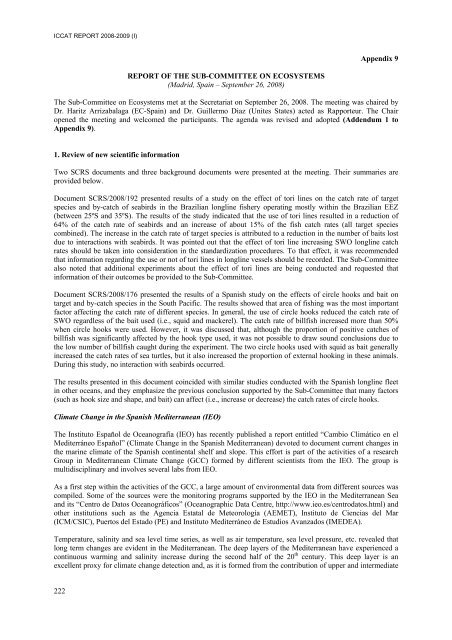REPORT OF THE STANDING COMMITTEE ON RESEARCH ... - Iccat
REPORT OF THE STANDING COMMITTEE ON RESEARCH ... - Iccat
REPORT OF THE STANDING COMMITTEE ON RESEARCH ... - Iccat
Create successful ePaper yourself
Turn your PDF publications into a flip-book with our unique Google optimized e-Paper software.
ICCAT <strong>REPORT</strong> 2008-2009 (I)Appendix 9<strong>REPORT</strong> <strong>OF</strong> <strong>THE</strong> SUB-<strong>COMMITTEE</strong> <strong>ON</strong> ECOSYSTEMS(Madrid, Spain – September 26, 2008)The Sub-Committee on Ecosystems met at the Secretariat on September 26, 2008. The meeting was chaired byDr. Haritz Arrizabalaga (EC-Spain) and Dr. Guillermo Diaz (Unites States) acted as Rapporteur. The Chairopened the meeting and welcomed the participants. The agenda was revised and adopted (Addendum 1 toAppendix 9).1. Review of new scientific informationTwo SCRS documents and three background documents were presented at the meeting. Their summaries areprovided below.Document SCRS/2008/192 presented results of a study on the effect of tori lines on the catch rate of targetspecies and by-catch of seabirds in the Brazilian longline fishery operating mostly within the Brazilian EEZ(between 25ºS and 35ºS). The results of the study indicated that the use of tori lines resulted in a reduction of64% of the catch rate of seabirds and an increase of about 15% of the fish catch rates (all target speciescombined). The increase in the catch rate of target species is attributed to a reduction in the number of baits lostdue to interactions with seabirds. It was pointed out that the effect of tori line increasing SWO longline catchrates should be taken into consideration in the standardization procedures. To that effect, it was recommendedthat information regarding the use or not of tori lines in longline vessels should be recorded. The Sub-Committeealso noted that additional experiments about the effect of tori lines are being conducted and requested thatinformation of their outcomes be provided to the Sub-Committee.Document SCRS/2008/176 presented the results of a Spanish study on the effects of circle hooks and bait ontarget and by-catch species in the South Pacific. The results showed that area of fishing was the most importantfactor affecting the catch rate of different species. In general, the use of circle hooks reduced the catch rate ofSWO regardless of the bait used (i.e., squid and mackerel). The catch rate of billfish increased more than 50%when circle hooks were used. However, it was discussed that, although the proportion of positive catches ofbillfish was significantly affected by the hook type used, it was not possible to draw sound conclusions due tothe low number of billfish caught during the experiment. The two circle hooks used with squid as bait generallyincreased the catch rates of sea turtles, but it also increased the proportion of external hooking in these animals.During this study, no interaction with seabirds occurred.The results presented in this document coincided with similar studies conducted with the Spanish longline fleetin other oceans, and they emphasize the previous conclusion supported by the Sub-Committee that many factors(such as hook size and shape, and bait) can affect (i.e., increase or decrease) the catch rates of circle hooks.Climate Change in the Spanish Mediterranean (IEO)The Instituto Español de Oceanografía (IEO) has recently published a report entitled “Cambio Climático en elMediterráneo Español” (Climate Change in the Spanish Mediterranean) devoted to document current changes inthe marine climate of the Spanish continental shelf and slope. This effort is part of the activities of a researchGroup in Mediterranean Climate Change (GCC) formed by different scientists from the IEO. The group ismultidisciplinary and involves several labs from IEO.As a first step within the activities of the GCC, a large amount of environmental data from different sources wascompiled. Some of the sources were the monitoring programs supported by the IEO in the Mediterranean Seaand its “Centro de Datos Oceanográficos” (Oceanographic Data Centre, http://www.ieo.es/centrodatos.html) andother institutions such as the Agencia Estatal de Meteorología (AEMET), Instituto de Ciencias del Mar(ICM/CSIC), Puertos del Estado (PE) and Instituto Mediterráneo de Estudios Avanzados (IMEDEA).Temperature, salinity and sea level time series, as well as air temperature, sea level pressure, etc. revealed thatlong term changes are evident in the Mediterranean. The deep layers of the Mediterranean have experienced acontinuous warming and salinity increase during the second half of the 20 th century. This deep layer is anexcellent proxy for climate change detection and, as it is formed from the contribution of upper and intermediate222
















